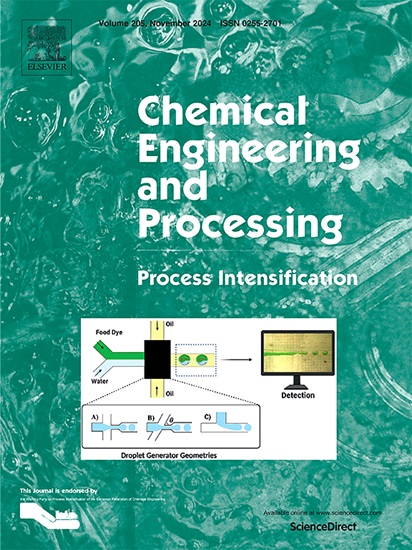Ultrasound-assisted extraction vs. microwave-assisted extraction for sustainable development goals: Selecting the ideal lipid extraction and fatty acid profile
IF 3.8
3区 工程技术
Q3 ENERGY & FUELS
Chemical Engineering and Processing - Process Intensification
Pub Date : 2024-10-20
DOI:10.1016/j.cep.2024.110035
引用次数: 0
Abstract
The objective of this study was to compare the efficiency of ultrasound-assisted extraction (UAE) and microwave-assisted extraction (MAE) methods for extracting lipids from the green microalga Chlorococcum novae-angliae. This study specifically focused on the fatty acid profiles of the extracted lipids, using ethanol as the solvent and wet biomass as the starting material. Ultrasound-assisted extraction yielded a maximum of 0.026 ± 0.001 g lipid/g wet biomass at a biomass ratio of 1:25 for 2 min with a 1-second cycle at 180 W and 20 kHz, which was 21% higher than that of microwave-assisted extraction conducted at a ratio of 1:30 for 2 min at 300 W and 35 °C. Ultrasound-assisted extraction enhanced saturated fatty acids (SFAs), which were 1.5 times higher than to microwave-assisted extraction, while microwave-assisted extraction significantly increased polyunsaturated fatty acids (PUFAs) by 4.4 times. The findings suggest that ultrasound-assisted extraction is more suitable for applications requiring high SFA content, such as in the fuel industry, whereas microwave-assisted extraction is preferable for sectors focused on fatty acid quality, such as food and health. This comparative analysis contributes to the literature by highlighting the impact of extraction methods on fatty acid profiles and supports sustainable development goals (SDGs), particularly SDG 12, by promoting environmentally friendly extraction techniques.
实现可持续发展目标的超声辅助提取与微波辅助提取:选择理想的脂质提取和脂肪酸谱
本研究的目的是比较超声波辅助萃取(UAE)和微波辅助萃取(MAE)法从绿色微藻绿球藻中提取脂质的效率。本研究以乙醇为溶剂,以湿生物质为起始材料,特别关注提取脂质的脂肪酸谱。在生物量比为 1:25 的条件下,超声辅助萃取在 180 瓦、20 千赫的条件下,以 1 秒为一个周期,持续 2 分钟,最高可获得 0.026 ± 0.001 克脂质/克湿生物量,比微波辅助萃取在生物量比为 1:30 的条件下,在 300 瓦、35 ℃ 的条件下,持续 2 分钟,最高可获得 0.026 ± 0.001 克脂质/克湿生物量高出 21%。超声波辅助萃取提高了饱和脂肪酸(SFAs)的含量,是微波辅助萃取的1.5倍,而微波辅助萃取显著提高了多不饱和脂肪酸(PUFAs)的含量,是微波辅助萃取的4.4倍。研究结果表明,超声辅助萃取更适用于对 SFA 含量要求较高的应用领域,如燃料工业,而微波辅助萃取则更适用于注重脂肪酸质量的领域,如食品和健康领域。这项比较分析强调了萃取方法对脂肪酸含量的影响,为文献做出了贡献,并通过推广环境友好型萃取技术,支持了可持续发展目标(SDGs),尤其是 SDG 12。
本文章由计算机程序翻译,如有差异,请以英文原文为准。
求助全文
约1分钟内获得全文
求助全文
来源期刊
CiteScore
7.80
自引率
9.30%
发文量
408
审稿时长
49 days
期刊介绍:
Chemical Engineering and Processing: Process Intensification is intended for practicing researchers in industry and academia, working in the field of Process Engineering and related to the subject of Process Intensification.Articles published in the Journal demonstrate how novel discoveries, developments and theories in the field of Process Engineering and in particular Process Intensification may be used for analysis and design of innovative equipment and processing methods with substantially improved sustainability, efficiency and environmental performance.

 求助内容:
求助内容: 应助结果提醒方式:
应助结果提醒方式:


